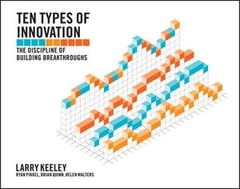 I was lucky enough to be able to attend the “Ten Types of Innovation” book launch party last night since it was held at The Institute of Design in Chicago, the first design school in the U.S. with a Ph.D. program, and an organization that we share a building with!
I was lucky enough to be able to attend the “Ten Types of Innovation” book launch party last night since it was held at The Institute of Design in Chicago, the first design school in the U.S. with a Ph.D. program, and an organization that we share a building with!
For those that are unfamiliar, Larry Keeley and his co-authors, have utilized the “Ten Types of Innovation” for more than a decade. The book being launched, “Ten Types of Innovation: The Discipline of Building Breakthroughs,” is an updated text that provides numerous examples of how recent innovation from well-known companies can be categorized using the “Ten Types of Innovation.” Further, the book discusses how the framework can be employed to help an organization develop structured innovation activities.
I thought it was great to hear Larry’s thoughts on the “Ten Types of Innovation” and the different contributions of his co-authors. His view is consistent with our understanding that innovation and discovery requires careful organization and analytical evaluation. As he stated, “People think innovation is about imagination and creativity but not so much.” His point was that it is a myth that innovation (as opposed to inventions or ideas) occurs through genus or epiphany, rather it takes persistence, hard work, and a structured, systematic process.
Wellspring shares the same worldview of structured innovation. Our work is about comprehensively mapping knowledge assets such as Intellectual Property, Expert Networks, Consumer Studies, and Product Tests that are all used to guide and support innovation. Similar to Larry, I do not believe a single R&D investment or inventive idea results in successful innovation. Rather, it is the effective use of accumulated knowledge and the broad set of expertise available within the firm. It is through access to unique knowledge bases that innovators can identify and launch innovations with a lasting competitive advantage.
Reflecting on process described by the Ten Types of Innovation I see that as a company we structure the knowledge resources of a firm so that they can more efficiently pursue all ten types.




